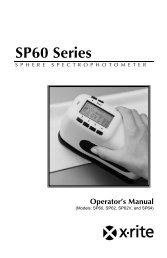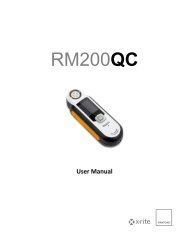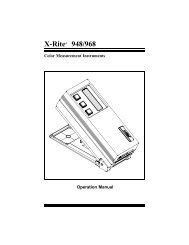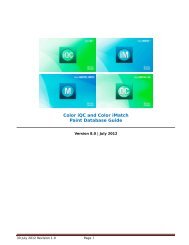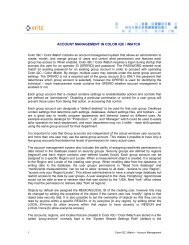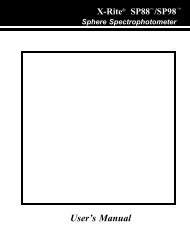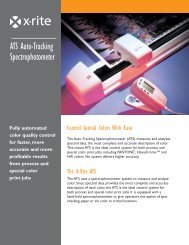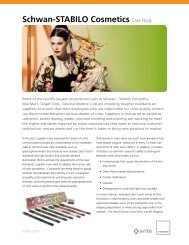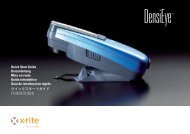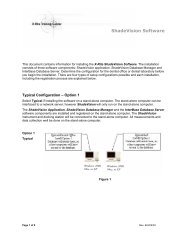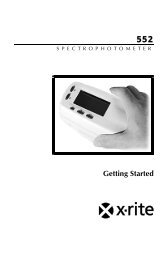X-Rite, Incorporated
X-Rite, Incorporated
X-Rite, Incorporated
You also want an ePaper? Increase the reach of your titles
YUMPU automatically turns print PDFs into web optimized ePapers that Google loves.
X-<strong>Rite</strong>, <strong>Incorporated</strong>NOTICE OF ANNUAL MEETINGOF SHAREHOLDERS ANDPROXY STATEMENTMay 4, 2004
X-RITE, INCORPORATED3100 44 TH Street, S.W.Grandville, Michigan 49418Notice of Annual Meeting of Shareholders to Be Held May 4, 2004The Annual Meeting of Shareholders of X-<strong>Rite</strong>, <strong>Incorporated</strong>, a Michigan Corporation, will be held atWestern Michigan University Conference Center, 200 Ionia Avenue, S.W., Grand Rapids, Michigan, onTuesday, May 4, 2004, at 4:30 p.m., for the following purposes:1. To elect four directors as set forth in the accompanying ProxyStatement.2. To approve the adoption of the X-<strong>Rite</strong>, <strong>Incorporated</strong> Amended and RestatedEmployee Stock Purchase Plan.3. To transact any other business that may properly come before themeeting, or any adjournment thereof.Shareholders of record as of the close of business on March 31, 2004, are entitled to notice of, and tovote at the meeting. We are pleased to offer multiple options for voting your shares. As detailed in the“Solicitation of Proxies” section of this Notice and Proxy Statement, you can vote your shares via the Internet,by telephone, by mail or by written ballot at the Annual Meeting. We encourage you to vote by the Internet as itis the most cost-effective method. Whether or not you expect to be present at this meeting, you are requestedto vote your shares using one of the methods discussed above. If you attend the meeting and wish to vote inperson, you may withdraw your Proxy.April 7, 2004Grandville, MichiganBy Order of the Board of DirectorsMary E. ChowningSecretaryDirections to Annual MeetingLocated in downtown Grand Rapids, The Western MichiganUniversity Conference Center is at the corner of Ionia Avenueand Cherry Street with parking on the corner opposite theCenter.South of Interstate 196 from U.S. 131, use exit 85A ifsouthbound on 131, or exit 84B if northbound on 131.2
X-RITE, INCORPORATED3100 44 TH Street, S.W.Grandville, Michigan 49418______________________PROXY STATEMENTApril 7, 2004______________________Solicitation of ProxiesThis Proxy Statement is furnished to the shareholders of X-<strong>Rite</strong>, <strong>Incorporated</strong>, in connection with thesolicitation by the Board of Directors of the Company of Proxies to be used at the Annual Meeting ofShareholders. The meeting will be held on Tuesday, May 4, 2004, at 4:30 p.m. at the Western MichiganUniversity Conference Center, 200 Ionia Avenue, S.W., Grand Rapids, Michigan. This Proxy Statementand the enclosed Proxy Card are being first mailed on or about April 7, 2004.Each shareholder, as an owner of the Company, is entitled to vote on matters scheduled to comebefore the Annual Meeting. The use of a Proxy allows a shareholder of the Company to be represented at theAnnual Meeting if he or she is unable to attend the meeting in person. There are four (4) ways to vote yourshares:1. By the Internet at http://www.eproxyvote.com/xrit.2. By toll-free telephone at 1-877-PRX-VOTE (1-877-779-8683)3. By completing and mailing your Proxy Card or Voter Instruction Form4. By written ballot at the Annual MeetingIf the enclosed Proxy Card is properly executed using any of the methods described above, the sharesrepresented by the Proxy will be voted at the Annual Meeting of Shareholders or at any adjournment of thatmeeting. Where shareholders specify a choice, the Proxy will be voted as specified. If no choice is specified,the shares represented by the Proxy will be voted for the election of the directors listed as nominees named inthe Proxy, in favor of approval of the X-<strong>Rite</strong>, <strong>Incorporated</strong> Amended and Restated Employee Stock PurchasePlan, and at the discretion of the Proxy voters on any other matters voted upon at the meeting. A Proxy may berevoked prior to its exercise by (1) delivering a written notice of revocation to the Secretary of the Company, (2)delivery of a later-dated Proxy, including by telephone or Internet vote, or (3) attending the meeting and votingin person. Attendance at the Annual Meeting, in and of itself, will not constitute a revocation of a Proxy.The cost of the solicitation of Proxies will be borne by the Company. In addition to the use of the mails,Proxies may be solicited personally or by telephone or facsimile by a few regular employees of the Companywithout additional compensation. The Company has retained D.F. King & Co., Inc., to aid in the solicitation ofproxies at an estimated cost of $4,800, plus expenses. In addition, brokers, nominees, custodians, and otherfiduciaries will be reimbursed by the Company for their expenses in connection with sending proxy materials tobeneficial owners.Voting Securities and Record DateThe Board of Directors has fixed March 31, 2004 as the record date for determining shareholdersentitled to vote at the Annual Meeting. On that date 20,725,116 shares of the Company’s common stock, parvalue $.10 per share, were issued and outstanding. Shareholders are entitled to one vote for each share of theCompany’s common stock registered in their names at the close of business on the record date. A majority ofthe shares entitled to vote represented in person or by proxy will constitute a quorum for action at the AnnualMeeting. Abstentions and broker non-votes are counted for the purposes of determining the presence orabsence of a quorum for the transactions of business. Abstentions are counted in tabulations of the votes caston proposals presented to shareholders, whereas broker non-votes are not counted for purposes ofdetermining whether a proposal has been approved.Election of DirectorsThe Company’s Articles of Incorporation specify that the Board of Directors shall consist of atleast six (6), but not more than nine (9) members, with the exact number to be fixed by the Board from time totime. The Board has fixed the number of directors at nine (9). The Articles also specify that the Board ofDirectors be divided into three classes, with the directors of the classes to hold office for staggered terms of3
Names, (Ages), Positions and Backgroundsof NomineesService as a DirectorNominees For Terms to Expire in 2006Michael C. Ferrara (61) is the CEO and President ofX-<strong>Rite</strong>, <strong>Incorporated</strong> and has held that position since Julyof 2003. For the period June 2001 to 2003, he served asPresident and COO of X-<strong>Rite</strong>, <strong>Incorporated</strong>. Previously,he was the President of Marine Optical Group, aworldwide design and marketing company in theeyewear business headquartered in Boston,Massachusetts, and he held that position for more thanfive years.Director since July 2003Directors Whose Terms Expire in 2005Stanley W. Cheff (62) is Chairman of the Board ofWolverine Building Group, a construction firm headquarteredin Michigan. Previously, Mr. Cheff served asPresident and Chief Executive Officer of WolverineBuilding Group, holding that position for more than fiveyears.James A. Knister (66) served in several seniormanagement positions for more than five years, includingChief Financial Officer, for Donnelly Corporation (nowMagna Donnelly Corporation) until his retirement in 1999.Magna Corporation is a manufacturer of glass relatedproducts for the automotive and electronics industries,head-quartered in Michigan.John E. Utley (63) retired in 1999 as Acting DeputyPresident of Lucas Varity Automotive. Lucas Varity washeadquartered in London, England prior to being sold toTRW, Inc. Prior to that, he served in several seniormanagement positions for more than five years,including Senior Vice President Strategic Marketing forVarity Corporation and served as Chairman of the Boardof both Kelsey Hayes Co. and Walbro Corporation.Director since 1996Chairman of Nominating & GovernanceCommittee and Member of theCompensation CommitteeDirector since 1996Member of the Nominating & GovernanceCommitteeDirector Since 2000Chairman of the Board of Directors andMember of the Audit CommitteeEx-officio member of all other BoardCommitteesDirectors Whose Terms Expire in 2006Paul R. Sylvester ( 44) is CEO and President ofManatron, Inc., a local government software and servicesprovider headquartered in Michigan, and has held thatposition since 1996. He joined Manatron in 1987 as itsVice President of Finance and CFO. He is a CPA andhas served on Manatron’s Board of Directors since 1987.Mark D. Weishaar (46) is CEO and President of SturgisMolded Products, a custom injection molding companyheadquartered in Michigan, and has held that positionsince 1997. Previously, he was Vice President ofBusiness Development at Moore Corporation Limited, amulti-national business forms printer. Mr. Weishaar is aCPA and served as Managing Partner for BDO Seidman,LLP where he worked for 13 years in various capacities.Director since January 2003Chairman of the Audit CommitteeDirector since January 2003Member of the Audit Committee5
Proposal to Amend and Restate Employee Stock Purchase PlanOn February 10, 2004, the Board of Directors adopted the X-<strong>Rite</strong>, <strong>Incorporated</strong> Amended and RestatedEmployee Stock Purchase Plan (the "Plan"), subject to approval of the shareholders of the Company. The followingsummary of the Plan is subject to the specific provisions contained in the complete text of the Plan set forth inAppendix A to this Proxy Statement. The purpose of the Plan is to provide our employees with an opportunity topurchase shares of common stock at a discount thereby acting as a further inducement to continue their employmentwith us and to encourage employees to increase their efforts to promote our best interests.GeneralThe Plan provides for the purchase by employees of the Company in the aggregate not more than 1,000,000shares of the common stock of the Company. The Plan is intended to replace a similar plan initially adopted by theBoard of Directors in November of 1994, last amended in 2000, and set to expire in November of 2004.The Plan enables eligible employees of the Company to acquire shares of common stock of the Companythrough payroll deductions and/or lump sum payments. Employee deductions or lump sum payments are credited toseparate employee accounts, and at the end of each purchase period the funds credited to each employee accountare used to purchase shares of common stock at a price currently equal to 85 percent of the then fair market value ofthe common stock.Eligibility and ParticipationCurrently, participation in the Plan is open to all of active employees ("Eligible Employees"), except (a)employees who have not been continuously employed by the Company for at least one year; (b) employees whosecustomary employment by us is less than 20 hours per week; and (c) employees whose customary employment is notfor more than five months in a calendar year. Purchase periods commence every fiscal quarter and end on the lastdate of each fiscal quarter.No Eligible Employee may purchase shares under the Plan (a) if such employee, immediately after receivingthe grant of an option under the Plan owns 5 percent or more of the combined voting power or value of the stock ofthe Company (as defined by Sections 423(b)(3) and 424(d) of the Internal Revenue Code of 1986, as amended); or(b) which permits such employee to purchase stock under the Plan aggregating more than $25,000 in any onecalendar year.An employee who is an Eligible Employee at or prior to the first day of any purchase period may become aparticipant as of such date by (a) completing and returning a payroll deduction authorization form (the "Authorization")to the Eligible Employee's appropriate payroll location at least 10 days prior to the first day of any purchase period; or(b) completing and forwarding a lump sum payment form furnished by the Company accompanied by payment of thelump sum at least 45 days prior to the last day of the purchase period. The Authorization will direct a regular payrolldeduction from the Eligible Employee's compensation to be made on each pay date occurring during each purchaseperiod in which the Eligible Employee is a participant. A participant may authorize a payroll deduction of not less thanTen and No/100 Dollars ($10.00) for each pay period and/or make one lump sum payment in any purchase period,subject to certain limitations in the Plan and the $25,000 calendar year limitation referred to above.Payroll deductions will be made by the Company for each participant in accordance with the Authorizationand will continue until the participant's participation terminates, his or her Authorization is revised or revoked, or thePlan terminates. By filing a new Authorization at least ten days prior to the beginning of any purchase period, aparticipant may increase or decrease his or her payroll deductions within the limits specified above.Purchase of SharesAll payroll deductions or lump sum payments made with respect to a participant will be credited to his or herstock purchase account ("Purchase Account"), which will be a non-interest bearing account.Each participant, during each purchase period, will be granted an option as of the last business day of thatpurchase period ("Purchase Date"), for the purchase of as many full shares of common stock, but not less than one(1) full share, as may be purchased with the funds in his or her Purchase Account. This option will be exercisedautomatically unless the participant terminates participation in the Plan. The purchase price for each share ofcommon stock is currently 85 percent of the fair market value of a share of stock on the Purchase Date. As of eachPurchase Date, the Purchase Account of each participant will be totaled and as many full shares will be purchased forthe participant as the Purchase Account will allow. Any balance remaining in a participant's Purchase Account after aPurchase Date will be carried forward in the Purchase Account for the following purchase period. Any balance6
emaining in a Purchase Account upon termination of employment or at the termination of the Plan will be automaticallyrefunded to the participant.If the Company's common stock is not traded in the NASDAQ Stock Market and does not become listed uponan established stock exchange, the fair market value for the shares to be purchased on each Purchase Date will bedetermined by the Board Committee.Shares issued to participants pursuant to the Plan will be from the Company's authorized but unissuedcommon stock. The Company reserves the right, however, to purchase shares in the over-the-counter market for issuanceto participants.Termination of ParticipationUpon a participant's retirement, death, or termination of employment, no payroll deduction will be taken fromany pay due and owing to him or her at such time. The balance in the Purchase Account will be paid to theterminating participant, or to his or her estate if termination results from death.A participant may, for any reason and at any time on written notice to us prior to the last pay date in anypurchase period, elect to terminate participation in the Plan and permanently draw out the balance accumulated in hisor her Purchase Account. Upon termination as a participant, the Authorization will be revoked with respect tosubsequent payroll deductions, and the amount in the Purchase Account and not payable in respect to the exercise ofany option to purchase stock theretofore granted under the Plan, as well as any payroll deductions made after suchrevocation, will be returned promptly to the former participant. An Eligible Employee who has thus terminatedparticipation in the Plan may thereafter begin participation in the Plan again, but only after the expiration of one (1)purchase period subsequent to the purchase period in which the Participant terminated enrollment in the Plan.In the event the Company terminates the Plan, or upon the expiration of the term of the Plan, all amounts inthe Purchase Accounts of participants will be promptly refunded. Rights under the Plan may not be transferred by aparticipant and are exercisable only by a participant during his or her lifetime.Administration, Termination and AmendmentThe Plan is administered by the Compensation Committee appointed by our Board of Directors (the"Committee"), which currently consists of three Directors who are not our officers or employees. The Board ofDirectors may remove members from or add members to the Committee and will fill any vacancies on the Committee.A majority of the Committee constitutes a quorum, and the acts of a majority of the members present at any meetingat which a quorum is present (or acts approved in writing by a majority of the members of the Committee) are validacts of the Committee. Unless otherwise determined by the Board of Directors, the interpretation and construction ofthe Plan by the Committee is binding.The Plan will terminate on May 4, 2014, unless the Company, through its Board of Directors, elects toterminate the Plan at any earlier time. The Board of Directors may also amend the Plan from time to time, except thatwithout the approval of the holders of a majority of our shares of stock entitled to vote, no amendment may (a)increase the number of shares approved for issuance under the Plan; (b) decrease the purchase price per share; or(c) modify the eligibility requirements for participation in the Plan.Federal Tax ConsequencesThe Plan is intended to be a qualified employees' stock purchase plan within the meaning of Section 423 ofthe Code. The consequences of the issuance and disposition of shares under the Plan are summarized below, basedon management's understanding of existing federal income tax laws.Funds credited to employee Purchase Accounts through payroll deductions are a part of currentcompensation taxable as ordinary income, although not actually received by employees. Under the Plan, an option topurchase shares from funds credited to an employee's Purchase Account is considered granted on the last day ofeach purchase period, and the simultaneous purchase of such shares at that time is considered to be the exercise ofthat option.Under the current provisions of the Code, if no disposition of the shares acquired under the Plan is made forat least two years after the date of exercise of the option, no income will be recognized by a participant at the time theoption is granted or exercised. This two-year holding period requirement will be deemed to be satisfied if the sharesacquired under the Plan are transferred after the death of an employee by his or her estate, or by a person whoacquired the shares by bequest or inheritance or by reason of the death of the employee, regardless of the length oftime the shares were owned by the participant.7
If shares acquired by a participant are sold after being held for the required holding period, the participant,upon disposition of the shares (or his or her estate upon the participant's death), will realize compensation taxable asordinary income, equal to the lesser of: (a) the amount by which the fair market value of the shares at the time ofdisposition or death exceeds the option exercise price (the purchase price for the stock); or (b) the amount by whichthe fair market value of the shares at the time the option was granted exceeded the option exercise price (thepurchase price for the stock). If the fair market value of the shares at the time of disposition exceeds the fair marketvalue of the shares at the time the option was granted, the difference between these amounts will be taxed as acapital gain. If the fair market value of the shares at the time of disposition or death is less than the option exerciseprice, no ordinary income is recognized and the difference between the option exercise price and the sale price istreated as a capital loss. No deduction is allowed to us as a result of the grant or exercise of or option to purchaseshares, except in the case of a disqualifying distribution described below.Disqualifying DispositionIf an employee disposes of shares purchased under the Plan before the expiration of the two-year holdingperiod, the disposition of the shares will be treated as a "disqualifying disposition", and the employee will not beentitled to the tax treatment described above. In the event of a disqualifying disposition, at the time the shares aredisposed of, the employee must include in his or her compensation the difference between the option exercise price(the purchase price for the stock) and the fair market value of the stock at the time of grant. The Company will thenbe entitled to a deduction for federal income tax purposes equal to the amount recognized as compensation by theemployee. The difference between the selling price, if applicable, and the option price (plus the amount recognized ascompensation) is treated as a capital gain or loss.Other InformationOn March 15, 2004, the closing price of the Company’s stock was $13.35 per share.Required Vote for ApprovalAt the Annual Meeting, the shareholders are being requested to consider and approve the Plan. Theaffirmative vote of the holders of the majority shares present or represented by proxy and entitled to vote at theAnnual Meeting is required to approve the Plan. Abstentions will be counted toward the total tabulation of the votescast on this proposal and will have the same effect as negative votes. Broker non-votes are counted towards aquorum, but are not counted for purposes of whether this proposal is approved.The Board of Directors recommends a vote FOR approval of the X-<strong>Rite</strong>, <strong>Incorporated</strong> Amended and RestatedEmployee Stock Purchase Plan.Governance of the CompanyThe Board has determined that a majority of the Directors are “independent” for purposes of compliance toThe Nasdaq Stock Market (“Nasdaq”) listing standards and Securities and Exchange Commission rules adopted toimplement provisions of the Sarbanes-Oxley Act of 2002, and that all of the members of the Audit Committee are also“independent” for purposes of Section 10A(m)(3) of the Securities Exchange Act of 1934 and Nasdaq listingstandards. The Board based these determinations primarily on a review of the responses of the Directors andexecutive officers to questions regarding employment and compensation history, affiliations and family and otherrelationships and on discussions with the Directors.The Board has adopted a charter for each of the three standing committees that address the make-up andfunctioning of the Board, along with a procedure for shareholder communications and the selection process for Boardcandidates. The Board has also adopted an Ethical Conduct Policy that applies to all of our employees, officers andDirectors; a Code of Ethics for Senior Executive Officers; and a Whistleblower’s Protection Policy. You can find linksto these materials on the Company’s website under Investor Relations at www.xrite.com.Board AttendanceEach member of the Board of Directors is expected to make a reasonable effort to attend all meetings of theBoard of Directors, all applicable committee meetings, and each Annual Meeting of Shareholders. While no formalpolicy with respect to attendance has been adopted, attendance at these meetings is encouraged and expected. Allmembers of the Board attended the 2003 Annual Meeting of Shareholders and each of the current members of theBoard is expected to attend the 2004 Annual Meeting of Shareholders. During fiscal 2003, the Board held sixmeetings and the committees held a total of 15 meetings. Each director attended at least 75 percent of the aggregatetotal of the number of meetings of the Board plus the total number of meetings of all applicable committees on whichsuch director served.8
Audit CommitteeThe Audit Committee focuses its efforts on the following three areas:• The adequacy of X-<strong>Rite</strong>, <strong>Incorporated</strong>’s internal controls and financial reporting process and the integrityof X-<strong>Rite</strong>, <strong>Incorporated</strong>’s financial statements;• The performance of X-<strong>Rite</strong>, <strong>Incorporated</strong>’s internal auditors and the qualifications, independence andperformance of X-<strong>Rite</strong>, <strong>Incorporated</strong>’s independent auditors; and• X-<strong>Rite</strong>, <strong>Incorporated</strong>’s compliance with legal and regulatory requirements.The committee meets periodically with management to consider the adequacy of X-<strong>Rite</strong>, <strong>Incorporated</strong>’sinternal controls and the financial reporting process. It also discusses these matters with X-<strong>Rite</strong>, <strong>Incorporated</strong>’sindependent auditors and with appropriate company financial personnel. The committee reviews our financialstatements quarterly and discusses them with management and the independent auditors before those financialstatements are filed with the Securities and Exchange Commission. During 2003, the Audit Committee held six (6)meetings.The committee regularly meets privately with the independent auditors, has the sole authority to retain anddismiss the independent auditors and periodically reviews their performance and independence from management.The independent auditors have unrestricted access and report directly to the committee.Audit Committee Financial Expert. The Board has determined that the Chairman of the committee, Mr. Sylvester, isan “audit committee financial expert,” as that term is defined in Item 401(h) of Regulation S-K, and “independent” forpurposes of current and recently-adopted Nasdaq listing standards and Section 10A(m)(3) of the Securities ExchangeAct of 1934. The Audit Committee operates under an Audit Committee Charter which was amended in 2003 and isattached as Exhibit B. The Charter is available on the Company’s website under Investor Relations at www.xrite.com.Report of the Audit CommitteeWe have reviewed X-<strong>Rite</strong>, <strong>Incorporated</strong>’s audited financial statements as of and for the fiscal year endedJanuary 3, 2004, and met with both management and Ernst & Young LLP, X-<strong>Rite</strong>, <strong>Incorporated</strong>’s independentauditors, to discuss those financial statements. Management has represented to us that the financial statements wereprepared in accordance with accounting principles generally accepted in the United States.Management has primary responsibility for the Company’s financial statements and the overall reportingprocess, including the Company’s system of internal controls. The independent auditors audit the annual financialstatements prepared by management, express an opinion as to whether those financial statements present fairly, inall material respects, the financial position, results of operations and cash flows of the company in conformity withaccounting principles generally accepted in the United States and discuss with us their independence and any othermatters they are required to discuss with us or that they believe should be raised with us. We oversee theseprocesses, although we must rely on the information provided to us and on the representations made by managementand the independent auditors.We have received from and discussed with Ernst & Young LLP the written disclosure and the letter requiredby Independence Standards Board Standard No. 1 (Independence Discussions with Audit Committees). These itemsrelate to that firm’s independence from the company. We also discussed with Ernst & Young LLP any matters requiredto be discussed by Statement on Auditing Standards No. 61, as amended (Communication with Audit Committees).Based on these reviews and discussions, we recommended to the Board that the Company’s auditedfinancial statements be included in X-<strong>Rite</strong>, <strong>Incorporated</strong>’s annual report on Form 10-K for the fiscal year endedJanuary 3, 2004.Paul R. Sylvester (Chair)John E. UtleyMark D. Weishaar9
Nominating and Governance CommitteeThe Nominating and Governance Committee (the "N&GC") is currently comprised of three members, and allof the members are nonemployee directors of the Company. The primary functions of the N&GC include assisting theBoard of Directors and the independent directors in matters related to Board composition and size, Board policies(e.g., term limits, service requirements, and retirement), nominations, evaluation of the Board and Board andmanagement succession, director orientation and education, and other corporate governance matters, as areappropriately delegated to it by the Board.The N&GC has a role in identifying director candidates consistent with criteria established by the Board,including the slate of directors presented for election at this Annual Meeting of Shareholders. Historically, theCompany has not had a formal policy concerning stockholder recommendations to the N&GC (or its predecessors).To date, the Company has not received any recommendations from stockholders requesting that the N&GC (or anypredecessor) consider a candidate for inclusion among the Committee’s slate of nominees in the Company’s proxystatement. The absence of such a policy does not mean, however, that a recommendation would not have beenconsidered had one been received. The N&GC will consider this matter fully during the upcoming year with a view toadopting and publishing a policy on stockholder recommendations for director nominees prior to the 2005 AnnualMeeting of Stockholders.In evaluating director nominees, the N&GC considers the following factors:• the appropriate size of the Company’s Board of Directors;• the needs of the Company with respect to the particular talents and experience of its directors;• the knowledge, skills and experience of nominees, including experience in technology, business, finance,administration or public service, in light of prevailing business conditions and the knowledge, skills andexperience already possessed by other members of the Board;• familiarity with national and international business matters;• experience with accounting rules and practices;• appreciation of the relationship of the Company’s business to the changing needs of society; and• the desire to balance the considerable benefit of continuity with the periodic injection of the fresh perspectiveprovided by new members.The N&GC’s goal is to assemble a Board of Directors that brings to the Company a variety of perspectivesand skills derived from high quality business and professional experience. In doing so the N&GC also considerscandidates with appropriate non-business backgrounds.Other than the foregoing there are no stated minimum criteria for director nominees, although the N&GC mayalso consider such other factors as it may deem are in the best interests of the Company and its stockholders. TheN&GC does, however, believe it appropriate for at least one, and, preferably, several, members of the Board to meetthe criteria for an “audit committee financial expert” as defined by SEC rules, and that a majority of the members ofthe Board meet the definition of “independent director” under NASDAQ rules. The N&GC also believes it appropriatefor certain key members of the Company’s management to participate as members of the Board.The N&GC identifies nominees by first evaluating the current members of the Board of Directors willing tocontinue in service. Current members of the Board with skills and experience that are relevant to the Company’sbusiness and who are willing to continue in service are considered for re-nomination, balancing the value of continuityof service by existing members of the Board with that of obtaining a new perspective. If any member of the Boarddoes not wish to continue in service or if the N&GC or the Board decides not to re-nominate a member for re-election,the N&GC identifies the desired skills and experience of a new nominee in light of the criteria above. Currentmembers of the N&GC and Board of Directors are polled for suggestions as to individuals meeting the criteria of theN&GC. Research may also be performed to identify qualified individuals. To date, the Company has not engaged thirdparties to identify or evaluate or assist in identifying potential nominees, although the Company reserves the right inthe future to retain a third party search firm, if necessary.10
While the N&GC is not composed entirely of independent directors, it is the goal of the Board of Directors forthe N&GC to be comprised of all independent members as quickly as is practical. Until the N&GC is comprisedentirely of independent directors, the independent directors oversee the activities of the N&GC as required byapplicable laws, rules, regulations, and listing standards. The N&GC operates under a Nominating and GovernanceCommittee Charter which is available on the Company’s website under Investor Relations at www.xrite.com. During2003, the N&GC held four (4) meetings.Compensation Committee - Report on Executive CompensationThe Compensation Committee is currently comprised of three members, and all of the members arenonemployee directors of the Company. The primary function of the Compensation Committee is to assist the Boardof Directors and the independent directors on the Board in matters related to compensation as may be appropriatelydelegated to it by the Board. While the Compensation Committee is not currently comprised entirely of independentdirectors, it is the goal of the Board for the Compensation Committee to be comprised of all independent members asquickly as is practical. Until the Compensation Committee is comprised entirely of independent directors, theindependent directors oversee the activities of the Compensation Committee as required by applicable law, rule,regulation, or listing standard.Compensation Philosophy. The Company's compensation policies are designed to enhance the Company'sability to attract, motivate, and retain competent and dedicated management. In constructing and applying thesepolicies, a conscious effort is made to identify and evaluate programs for comparable employers, considering factorssuch as geography and industry influences, relative sizes, growth stages, and market capitalization. In fulfilling its roleto assist the Board of Directors and the independent directors, the Compensation Committee has, at times, enlistedthe assistance of a consulting firm to establish a peer group of corporations that can be used for compensationcomparison purposes.Components of Compensation. In general, compensation packages for executive officers are composed ofthree elements: base salary; annual bonus; and stock-based incentives. Base salary for an executive is determined bythe executive's responsibilities and the Company's need to be competitive in the market for executive services. Bonuscompensation is based on achievement of individual and corporate goals. Stock-based incentives are intended tostrengthen the alignment of the interest between the shareholders and senior management and to address long-termperformance. The Board of Directors believes the stock ownership of management is of critical importance to theongoing success of the Company. In the early part of 2003, the Compensation Committee reviewed the annual salaryplan with the Chief Executive Officer ("CEO") for all of the Company's executive officers, and provided input to theindependent directors and the entire Board of Directors to make such adjustments as the independent directors andBoard of Directors determined appropriate based upon salary survey data for comparable employers, economicconditions in general, and evaluations by the CEO. Annual salary for the CEO was reviewed by the independentdirectors and the entire Board of Directors and adjusted based on the same considerations for other executivesalaries, plus input from the N&GC and its evaluation of the CEO's performance. The Company established a bonusprogram for 2003 applicable to all executive officers of the Company. The program has two components. Onecomponent is based on individual performance as determined by the independent directors and the entire Board ofDirectors based on the input of the Compensation Committee, in conjunction with the CEO with respect to otherofficers. The second component is based on Company-wide economic performance defined to be roughly the returnon average assets. Bonuses, if any, are reported in the Summary of Compensation Table contained in this ProxyStatement.The Company, by its independent directors and the entire Board of Directors (with the input of theCompensation Committee), also awarded stock options to six (6) officers during 2003 under the Company's EmployeeStock Option Plan, including grants to the named executive officers detailed in the table captioned "Option Grants inLast Fiscal Year" contained herein. The options awarded to the executives other than the CEO were based onevaluations provided by the CEO, and input provided by the Compensation Committee and the N&GC to theindependent directors and the entire Board of Directors. Each executive's contribution to achieving agreed upon goals,his or her ability and willingness to influence success, and striving to achieve individual and corporate goals were keyfactors in the independent directors and Board of Directors determinations. The CEO was also awarded options basedprimarily on the concept that it is in the best interest of the shareholders to provide incentives for the CEO in the formof stock options, in an amount appropriate relative to the options granted to other executives considering their abilitiesto influence performance.11
Compliance. During 2003, the Company complied with current NASDAQ rules with respect to independentdirector and/or entire Board of Directors approval of CEO compensation in an executive session where the CEO is notpresent as well as independent director and/or entire Board of Directors approval requirements of all executive officercompensation. The Compensation Committee operates under a Compensation Committee Charter which is availableon the Company’s website under Investor Relations at www.xrite.com. During 2003, the Compensation Committeeheld five (5) meetings.Compensation of DirectorsCompensation Committee:Ronald A. VandenBerg, ChairmanStanley W. CheffPeter M. Banks.Independent Directors:John E. UtleyRonald A. VandenBergL. Peter FriederPaul R. SylvesterMark D. WeishaarOur outside Directors, that is Directors who are not employees of X-<strong>Rite</strong>, <strong>Incorporated</strong>, receive an annualretainer of $20,000 ($37,000 for chairperson), plus a meeting fee of $1,000 ($1,500 for chairpersons) for each meetingof the Board or a committee attended with the exception of the Audit Committee where a meeting fee of $1,500($2,000 for chairperson) is paid. In addition, each outside director immediately following each Annual Meeting ofShareholders is entitled to receive an option to purchase 8,000 shares of the Company’s common stock at a price pershare equal to the fair market value on the previous day. Each option has a term of ten years and becomesexercisable six months following the date of issue.Shareholder Communications with DirectorsThe Board has adopted a process for shareholder communications and the selection of new Boardcandidates. You can find links to these materials on the Company’s website under Investor Relations at:www.xrite.com. Generally, shareholders who want to communicate with the Board or any individual Director can writeto:X-<strong>Rite</strong>, <strong>Incorporated</strong>Corporate Secretary3100 44 th Street, S.W.Grandville, Michigan 49418Your letter should indicate that you are an X-<strong>Rite</strong>, <strong>Incorporated</strong> shareholder. Depending on the subjectmatter, management will:• Forward the communication to the Director or Directors to whom it is addressed;• Attempt to handle the inquiry directly, for example where it is a request for information about the companyor it is a stock-related matter; or• Not forward the communication if it is primarily commercial in nature or if it relates to an improper orirrelevant topic.At each Board meeting, a member of management presents a summary of all communications receivedsince the last meeting that were not forwarded and makes those communications available to the Directors onrequest.12
Our Relationship with Our Independent AuditorsThe consolidated financial statements of the Company and its subsidiaries for the year ended January 3,2004, have been audited by Ernst & Young LLP, independent public accountantsThe aggregate fees billed by Ernst & Young LLP for the fiscal year ended January 3, 2004 are as follows:2003 2002Audit Fees $290,184 $230,750Audit Related Fees 61,200 3,570Tax Fees 42,971 2,655Other Fees - -$394,355 $237,155Audit fees were for professional services rendered for the audit of the Company’s annual financialstatements, the review of quarterly financial statements, and the preparation of statutory and regulatory filings. Auditrelatedfees consist principally of audit work performed on the consolidated financial statements, as well as workgenerally only the independent auditor can reasonably be expected to provide, such as statutory audits. Tax feesconsist of fees billed for return preparation and consulting services.Preapproval Policy for Auditor ServicesThe Audit Committee's policy is to preapprove all audit and nonaudit services provided by the Company'sindependent auditors. These services may include audit services, audit related services, tax services, and otherservices. Preapproval is generally provided for up to one (1) year and any preapproval is detailed as to a particularservice or category of services and is generally subject to a specific budget. The Audit Committee has delegatedpreapproval authority to its Chairperson when expedition of service is necessary. Both the Company's independentauditors and management are required to periodically report to the whole Audit Committee regarding the extent ofservices provided by the Company's independent auditors in accordance with this preapproval policy, and the fees forsuch services.Appointment of Auditors for Fiscal 2004The Audit Committee has reappointed Ernst & Young LLP as the independent public accounting firm to auditour financial statements for fiscal 2004.Representatives of Ernst & Young LLP will be present at the meeting. They will be given the opportunity tomake a statement if they desire to do so, and they will be available to respond to appropriate questions.Section 16(a) Beneficial Ownership Reporting ComplianceBased upon a review of Forms 3, 4, and 5 furnished to the Company during or with respect to the precedingfiscal year and written representations from certain reporting persons, the Company is not aware of any failure by anyreporting person to make timely filings of those Forms as required by Section 16(a) of the Securities Exchange Act of1934, except with respect to the following Form 4 filing by: (1) Ronald A. Vandenberg covering the exercise of anoption to buy and open market sale of 10,000 shares on July 8, 2003 which was reported 5 days late, and (2) theomission of 13,000 options on Form 3 by James M. Weaver granted prior to his becoming an officer of the Companyand correctly filed on Form 5 on January 13, 2004.13
Securities Ownership of ManagementThe following table contains information regarding ownership of the Company’s common stock by eachdirector and nominee for election as a director, each executive officer named in the tables under the caption ExecutiveCompensation, and all directors and executive officers as a group. The content of this table is based upon informationsupplied by the persons identified in the table and represents the Company’s understanding of circumstances inexistence as of March 1, 2004.Amount and Nature of OwnershipName of Beneficial OwnerSharesBeneficiallyOwned (1)ExercisableOptions (2)TotalPercent ofClass (3)Joan Mariani Andrew 22,681 125,000 147,681 *Peter M. Banks 0 48,000 48,000 *Bernard J. Berg 30,842 130,000 160,842 *Stanley W. Cheff 3,000 78,000 81,000 *Michael C. Ferrara 20,713 92,500 113,213 *L. Peter Frieder 5,250 0 5,250 *James A. Knister 2,000 78,000 80,000 *Jeffrey L. Smolinski 24,284 100,000 124,284 *Paul R. Sylvester 500 10,455 10,955 *John E. Utley 5,000 38,000 43,000 *Ronald A. VandenBerg 8,666 78,000 86,666 *James M. Weaver 1,100 13,000 14,100 *Mark D. Weishaar 3,000 10,455 13,455 *All Directors and ExecutiveOfficers as a Group(14 persons)127,178 801,410 928,588 4.6*Less than one percent(1)(2)(3)Each person named in the table has sole voting and investment power with respect to the issued shares listed in this column.This column reflects shares subject to options exercisable as of March 1, 2004, or within 60 days thereafter.The percentages are calculated on the basis of the number of outstanding shares of common stock plus common stock deemedoutstanding pursuant to rule 13d-3.14
Securities Ownership of Certain Beneficial OwnersThe following table contains information regarding ownership of the Company’s common stock by persons orentities beneficially owning more than five percent (5%) of the Company's common stock. The content of this table isbased upon information contained in Schedules 13G furnished to the Company and represents the Company’sunderstanding of circumstances in existence as of March 1, 2004.Name and Address ofBeneficial OwnerAmount and Natureof Beneficial OwnershipPercent ofClass (3)Putnam Investments, Inc.One Post Office SquareBoston, MA 021092,087,186 10.1Ted Thompson1980 76 th Street, SWByron Center, MI 493151,475,800(1)7.2Rufus S. Teesdale3152 East Gatehouse, S.E.Grand Rapids, MI 495461,396,983(2)6.8Kern Capital Management, LLC114 West 47 th StreetNew York, New York 100361,362,200 6.6(1)(2)(3)Mr. Thompson is one of the original founders of the Company. His holdings Include 107,500 shares subject tooptions exercisable within 60 days, and includes 160,000 shares issued to a trust established by Mr.Thompson’s wife, and he disclaims beneficial ownership of those 160,000 shares.Mr. Teesdale is one of the original founders of the Company. His holdings include 80,000 shares subject tooptions exercisable within 60 days.The percentages are calculated on the basis of the number of outstanding shares of common stock pluscommon stock deemed outstanding pursuant to rule 13d-3.15
Executive CompensationThe following table contains information regarding compensation paid by the Company with respect to eachof the last three fiscal years to its chief executive officer and to the four other most highly compensated executiveofficers who were serving at the end of fiscal year 2003 for services rendered to the Company (the “named executiveofficers”).Michael C. Ferrara (4)Chief Executive OfficerJoan Mariani AndrewVice PresidentGlobal SalesYear200320022001200320022001RestrictedSummary Compensation TableLong TermCompensationAnnual($) ($) (2) ($)CompensationStockSalaryBonus Award(s)323,029 591,974 137,988(1)267,50020,000(5)174,58366,875-311,425302,075190,000(6)(6)232,126------SecuritiesUnderlyingOptions(#)75,00017,50017,50020,00015,00015,000All OtherCompensation($) (3)10,11414,4314,1188,15311,13811,013Bernard J. BergSenior Vice PresidentEngineering200320022001200,000200,000200,000244,34310,000----20,00015,00015,00019,86513,62913,254Jeffrey L. SmolinskiVice PresidentOperations200320022001189,904185,000185,000232,008-----20,00015,00015,00010,15711,13811,013James M. Weaver (7)Vice PresidentProduct Development& Marketing20032002170,086140,769207,80971,307--8,0003,0008,4009,401(1)(2)(3)(4)(5)(6)(7)As part of Mr. Ferrara revised employment contract, he received an award of 10,000 shares of restricted stock on December 31,2003. The shares were issued under the Company’s Second Restricted Stock Plan effective March 13, 1999. The price used tocalculate the value of the shares was $11.80, representing the closing price of X-<strong>Rite</strong> stock on the day prior to grant. Alsoincluded is the value of restricted stock pursuant to the Cash Bonus Conversion Plan of $19,998. Restrictions lapse as to 20percent of the shares six months after grant and as to 20 percent on each of the first four anniversaries of the grant date, or as toall shares in the event of death, disability, retirement, or change in control of the Company. Dividends are paid on these shares tothe same extent paid on the Company’s common stock. Mr. Ferrara held 4,264 restricted shares of stock acquired through theCash Bonus Conversion Plan.Bonuses paid to the executive officers may be converted into common stock of the Company, at the election of the executive,pursuant to the Company’s Cash Bonus Conversion Plan. Bonuses are converted at a discount of 50 percent from the marketvalue of the stock at the time the bonus is determined. The shares received are subject to certain restrictions on transfer and risksof forfeiture.These amounts represent "matching" contributions by the Company pursuant to its 401(k) Plan, annual premiums for term lifeinsurance, auto allowance, and adoption assistance attributable to each named executive officer.Michael C. Ferrara became President of the Company on July 9, 2001, and was appointed as its Chief Executive Officer in July of2003.Included in this amount is base compensation of $108,029 and relocation payments of $66,554.Included in this amount is base compensation of $190,000 and cost of living, currency and tax differential payments forassignment outside of the U.S.James M. Weaver became Vice President, Product Development and Marketing of the Company on July 28, 2003. Mr. Weaverjoined the Company in December of 2001as the General Manager of the Match<strong>Rite</strong> product line.16
The following table contains information regarding stock options granted to the named executive officersduring the preceding fiscal year.Option Grants in Last Fiscal YearNumber ofSecuritiesUnderlyingOptionsGranted (1)Percent of OptionsGranted toAll EmployeesIn Fiscal YearExercisePrice($/sh) (2)ExpirationDateGrant DatePresent Value($) (3)Michael C. Ferrara 25,00050,0008.416.97.129.181/28/133/24/1381,500210,744Joan Mariani Andrew 20,000 6.7 7.12 1/28/13 65,200Bernard J. Berg 20,000 6.7 7.12 1/28/13 65,200Jeffrey L. Smolinski 20,000 6.7 7.12 1/28/13 65,200James M. Weaver 8,000 2.7 9.99 4/28/13 36,880(1)(2)(3)Options become exercisable one year after the date of grant.The exercise price is the closing price of the Company’s stock on the day prior to the grant date. The price may be paid in cash orby the surrender of outstanding shares.Present value calculated under the Black-Scholes Valuation Model, assuming a risk-free rate of return of 2.90 to 3.12 percent,1.06 percent dividend yield, 54 percent volatility, and exercise in 5 years. This model is an alternative suggested by the Securitiesand Exchange Commission, and the Company neither endorses this particular model nor necessarily agrees with the method forvaluing options. The future performance of the Company and the price of its shares will ultimately determine the value of theseoptions.The following table contains information regarding the exercise of options during fiscal 2003 by the namedexecutive officers, as well as unexercised options held by them at fiscal year-end.Aggregate Option Exercises in Last Fiscal Year and Year-end ValuesSharesAcquiredonExercise(#)ValueRealized($)Number of SecuritiesUnderlying UnexercisedOptions at FiscalYear-EndExercisable UnexercisableValue of UnexercisedIn-the-Money Options atFiscalYear-EndExercisable Unexercisable(1)Michael C. Ferrara 17,500 43,793 17,500 75,000 41,125 236,750Joan Mariani Andrew - - 105,000 20,000 258,300 90,600Bernard J. Berg - - 120,000 20,000 258,300 90,600Jeffrey L. Smolinski - - 110,000 20,000 258,300 90,600James M. Weaver - - 2,000 11,000 7,300 26,450(1)2003.Based upon the closing price of $11.65 per share of common stock on January 2, 2004, which is the last trading day of fiscal year17
The following table provides information about the Company’s equity compensation plans as of January 3, 2004.The table does not include shares that may be issued under the February 10, 2004 Amended and Restated EmployeeStock Purchase Plan which is being submitted for approval at the Annual Meeting.Equity Compensation Plan SummaryNumber of securitiesto be issued uponexercise ofoutstanding optionsWeighted-averageexercise price ofoutstanding optionsNumber of securitiesRemaining available forFuture issuance underCompensation plans(excluding securitiesreflected in the first column)Equity compensation plansapproved by shareholders 2,067,461 (1) $11.25 4,347,633 (2)Equity compensation plansnot approved by shareholders 0 n/a 0Total 2,067,461 4,347,633(1)(2)Represents outstanding options to purchase the Company’s Common Stock granted under the X-<strong>Rite</strong>, <strong>Incorporated</strong> 2003 and1993 Employee Stock Option Plans, as amended and restated, and the X-<strong>Rite</strong>, <strong>Incorporated</strong> 2003 and 1993 Outside DirectorsStock Option Plans, as amended and restated.Represents options available to purchase the Company’s common stock under the X-<strong>Rite</strong>, <strong>Incorporated</strong> 2003 Employee Stock OptionPlan and the X-<strong>Rite</strong> <strong>Incorporated</strong> 2003 Outside Director Stock Option Plan. Included are 708,594 shares available for issuance underthe November 15, 1994 Amended and Restated Employee Stock Purchase Plan.Stock Performance GraphThe following graph depicts the cumulative total return on the Company’s common stock compared to thecumulative total return on the indices for NASDAQ Stock Market (U.S. and foreign) and NASDAQ nonfinancial stockswhich is considered to be the Company’s peer group. The graph assumes an investment of $100 on the last tradingday of 1998, and reinvestment of dividends in all cases.Comparison of Five-Year Cumulative Total ReturnsPerformance Report forX-<strong>Rite</strong>, <strong>Incorporated</strong>$400.00$300.00X-<strong>Rite</strong>Nasdaq Stock M arket (US & Foreign)Nasdaq Stock Non-Financial Stocks$200.00$100.00$0.001998 1999 2000 2001 2002 2003Year Ended December 31Cumulative Total Return12/98 12/99 12/00 12/01 12-02 12/03X-<strong>Rite</strong>, <strong>Incorporated</strong> 100 81 101 110 90 146Nasdaq Stock Market (US & Foreign) 100 186 113 89 61 49Nasdaq Stock Non-Financial Stocks 100 196 114 88 57 4518
Other ArrangementsThe Company has not adopted any long-term incentive plan or any defined benefit or actuarial plan, as thoseterms are defined in the applicable regulations promulgated by the Securities and Exchange Commission.Effective as of a change in control of the Company, the Company has made available to its executive officers’contracts assuring them of continued employment for a period of three years. In the event of a change in control andthe executive's employment is terminated by the Company during the three-year employment term without goodcause, either actually or constructively, the executive is entitled to receive continued compensation and employeebenefits for the remainder of the term.At the time CEO Cook retired from his position as the Company’s chief executive officer and as a director, theCompany entered into an agreement with Mr. Cook in connection with the settlement of Mr. Cook’s employmentcontract. Under Mr. Cook’s Separation Agreement entered into effective as of March 7, 2003, he is entitled to 18months of his former $325,000 annual base salary, which payments will be made in substantially equal installmentsover an 18-month period. Mr. Cook also was granted vesting of certain unvested stock options and certain unvestedshares in the Company’s Cash Bonus Conversion Plan. Mr. Cook is obligated (i) to be reasonably available to provideinformation, transition assistance and other services at the request of the Company during the period of severance, (ii)not to compete with the Company or solicit its employees for a period of two years after his retirement, and (iii) to holdconfidential any proprietary information of the Company.CEO Ferrara has an Employment Agreement with the Company for an initial term of approximately fouryears, ending December 1, 2007, renewable annually thereafter for three successive one-year periods unlessterminated by either party as of the end of the initial term or any renewal term. During its continuation, either partymay terminate the Agreement for specified reasons. Mr. Ferrara is entitled to receive cash compensation for aminimum of eighteen months and certain perquisites for the unexpired portion of the then current term if hisemployment is terminated for any reason other than death, disability, voluntary quit, or discharge for good cause. Mr.Ferrara is obligated not to compete with the Company or solicit its employees for a period of two years aftertermination of his employment. Mr. Ferrara's Agreement has been coordinated with the above-described change incontrol arrangement in the event a change in control of the Company occurs.At the time former Chairman Ted Thompson retired from his position as the Company's Chief ExecutiveOfficer and retired from day-to-day management of the Company's affairs, the Company entered into an agreementwith Mr. Thompson for the purpose of defining an ongoing relationship with the Company. In addition to specifying hisresponsibilities, compensation, and benefits, the agreement provided for compensation and insurance benefits for aperiod of five years after conclusion of his service as Chairman. On September 13, 2001, Mr. Thompson retired asChairman of the Company and an amendment to that agreement was entered into providing Mr. Thompson certainhealth benefits in lieu of certain compensation. Mr. Thompson is obligated not to compete with the Company for aperiod ending two years after termination of the agreement.At the time CFO Kluting retired from his position as the Company’s chief financial officer, the Companyentered into a separation agreement with Mr. Kluting. Under Mr. Kluting’s Separation Agreement effective as of July24, 2003, he is entitled to 15 months of his former $210,000 annual base salary, which payments will be made insubstantially equal installments over a 15 month period and received a full incentive bonus for fiscal year 2003 in theamount of $255,000. Mr. Kluting also was granted vesting of certain unvested stock options and certain unvestedshares in the Company’s Cash Bonus Conversion Plan. Mr. Kluting is obligated (i) to be reasonably available toprovide information, transition assistance and other services at the request of the Company during the period ofseverance, (ii) not to compete with the Company or solicit its employees for a period of two years after his retirement,and (iii) to hold confidential any proprietary information of the Company.Any director of the Corporation serving prior to February 10, 2004, who serves the shorter of at least: (i) nineyears or (ii) three maximum length terms of office as a director and who either resigns as a director or does not standfor reelection, shall be entitled to be considered for the position of "Director Emeritus." If nominated by the Nominatingand Governance Committee and elected by the Board of Directors, a Director Emeritus shall continue in that positionfor a period equal to the time served as a regular director prior to February 10, 2004, or until an earlier resignation ordeath. During their tenure, Directors Emeritus shall be given notices of all meetings of the Board of Directors, andthey shall perform such consulting services for the Corporation as the Board of Directors may reasonably request fromtime to time. Directors Emeritus shall be entitled to attend and participate in all such meetings of the Board ofDirectors, except that they may not vote and they shall not be counted for purposes of determining a quorum.Directors Emeritus shall receive an annual cash retainer fee equal to the lesser of: (i) the annual cash retainer fee inplace at the time the director resigned as a director or did not stand for reelection; or (ii) the annual cash retainer feein place at any time during the period such director holds the position of Director Emeritus, and shall be entitled toreimbursement for expenses of attendance at meetings of the Board, but they shall receive no other compensationfrom the Corporation.19
Certain Relationships and Related TransactionsXR Ventures, LLC is a joint venture between the Company and Peter M. Banks and James A. Knister. Themain focus of XR Ventures was to find, acquire, develop, and operate interests in businesses or technologiesimportant to the growth of new markets for the Company. Prior to December 2003, Mr. Banks and Mr. Knister wereresponsible for the day-to-day operations of XR Ventures with input from the Company. The Company funded allacquisitions made by XR Ventures and, in exchange, will receive its investment back in full before any distributionsare made. The Company will receive 80 percent of the gains on investments. Dr. Banks and Mr. Knister will receive 20percent of the gains on investments. Mr. Banks and Mr. Knister are reimbursed for their expenses, but receive nosalary or additional Board fees relating to XR Ventures. The Company reached the XR Ventures arrangement with Mr.Banks and Mr. Knister through arms-length negotiation, in which the Company was represented by it regular counseland Mr. Banks and Mr. Knister were represented by separate counsel. In December of 2003, the Company, Mr.Banks and Mr. Knister amended the XR Ventures, LLC agreement, and Mr. Banks and Mr. Knister resigned asmanaging members in XR Ventures, LLC. Mr. Banks and Mr. Knister remain members of XR Ventures, LLC, but haveno formal day to day operating duties.The Company entered into a five year lease on October 2, 2000 on a facility owned by a partnership in whichStanley W. Cheff is a fifty percent partner. The Company paid $237,895 of rent during 2003 for this facility. The leaseagreement was reached through arms-length negotiation with the partnership which was represented by its owncounsel. The Board of Directors believes the terms of this lease are at least as favorable to the Company as couldhave been obtained from unrelated parties.Shareholder Proposals – Annual MeetingAny proposal of a shareholder intended to be presented at the 2005 Annual Meeting of Shareholders of theCompany must be received by the Company at its headquarters, 3100 44 th Street, S.W., Grandville, Michigan 49418,no later than December 9, 2004. Shareholders who wish to submit a proposal not intended to be included in theCompany’s Proxy Statement relating to the 2005 Annual Meeting, but to be presented at that meeting, and whopropose to nominate a director for election at that meeting, are required by the Company’s Articles of Incorporationand Bylaws to provide notice of such proposal or nomination to the Company. Nominations for directors must bereceived not later than thirty days prior to the date of the Annual Meeting (or within seven days after the Companymails, or otherwise gives notice of the date of such meeting, if such notice is given less than forty days prior to themeeting date). All other proposals must be received not less than sixty nor more than ninety days prior to thescheduled meeting date, provided, that if less than seventy days notice, or prior public disclosure of the date of ascheduled meeting is given or made, notice by the shareholder to be timely must be received not later than the closeof business on the tenth day following the earlier of the day on which such notice of the date of the scheduled meetingwas mailed or the day on which such public disclosure was made. This notice must contain the information requiredby the Company's Articles Incorporation and Bylaws and must be submitted in accordance with the proceduresoutlined therein.MiscellaneousThe Company’s Annual Report to Shareholders including financial statements, as well as the Company’sannual report on Form 10-K, is being mailed to shareholders with this Proxy Statement.Management is not aware of any matters to be presented for action at the Annual Meeting other than as setforth in this Proxy Statement. If other business should come before the meeting, the persons named as proxy holdersin the accompanying Proxy intend to vote the shares in accordance with their judgment, and discretionary authority todo so is included in the Proxy.SHAREHOLDERS ARE URGED TO PROMPTLY DATE, SIGN, AND RETURNTHE ACCOMPANYING PROXY IN THE ENCLOSED ENVELOPE.By Order of the Board of DirectorsMary E. ChowningSecretaryApril 7, 2004Grandville, Michigan20
Appendix AX-RITE, INCORPORATEDAMENDED AND RESTATED EMPLOYEE STOCK PURCHASE PLAN(Adopted February 10, 2004)1. Purpose. The purpose of this X-<strong>Rite</strong>, <strong>Incorporated</strong> Amended and Restated Employee StockPurchase Plan is to provide employees of the Company with a further inducement to continue their employment withthe Company and to encourage those employees to increase their efforts to promote the best interests of theCompany. The Plan allows Eligible Employees to purchase Stock at a price less than the market price under Section423 of the Internal Revenue Code of 1986, as amended (the "Code").2. Definitions. The following words and phrases shall have the following meanings as used in this Plan:a. "Authorization" means the payroll deduction direction specified in Section 7 of this Plan.b. "Board" means the Board of Directors of X-<strong>Rite</strong>, <strong>Incorporated</strong>.c. "Committee" means the committee appointed by the Board to administer the Plan.d. "Company" means X-<strong>Rite</strong>, <strong>Incorporated</strong>, as well as any subsidiary corporation that is morethan fifty percent (50%) controlled by X-<strong>Rite</strong>, <strong>Incorporated</strong>, directly or indirectly, and which has been approved by theBoard for inclusion in the Plan.e. "Eligible Employee" means a person meeting the requirements of Section 4 of this Plan.f. "Market Value" means the closing sale price reported in the Nasdaq Stock Market or, if suchvalue is not available, such other estimate of fair market value as the Committee shall determine.g. "Participant" means an Eligible Employee who has elected to participate in this Plan.Plan.8 of this Plan.h. "Plan" means this X-<strong>Rite</strong>, <strong>Incorporated</strong> Amended and Restated Employee Stock Purchasei. "Purchase Account" means the account established for a Participant as provided in Sectionj. "Purchase Period" means each fiscal quarter of the Company.k. "Stock" means the common stock of X-<strong>Rite</strong>, <strong>Incorporated</strong>, par value $0.10 per share.3. Administration.a. The Plan shall be administered by a Committee appointed by the Board as the Board shalldetermine from time to time. A majority of members of the Committee shall constitute a quorum for the transaction ofbusiness. The Committee shall be responsible to the Board for the operation of the Plan, and the interpretation andconstruction of any provision of the Plan by the Committee shall be final and binding, unless otherwise determined bythe Board of Directors. No member of the Board of Directors or the Committee shall be liable for any action ordetermination made in good faith with respect to the Plan.b. The Committee shall consist entirely of members who are Non-Employee Directors as suchterm is defined in Rule 16b-3 promulgated by the Securities and Exchange Commission.c. Each person who is or shall have been a member of the Committee shall be indemnified andheld harmless by the Company, to the maximum extent permitted by law, from and against any cost, liability, orexpense imposed or incurred in connection with such persons taking or failing to take any action under the Plan.4. Eligibility. All active employees of the Company shall be Eligible Employees, entitled to participateunder the Plan, except: (a) employees who have been continuously employed by the Company for less than oneyear; (b) employees whose customary employment by the Company is for less than 20 hours per week; and (c)employees whose customary employment by the Company is not for more than five months in a calendar year. Nooption rights shall be granted under the Plan to any person who is not an Eligible Employee, and no Eligible Employee21
shall be granted option rights under the Plan: (a) if such employee, immediately after receiving the grant of suchoption rights under the Plan, owns (under the rules of Sections 423(b)(3) and 424(d) of the Code) stock possessing 5percent or more of the total combined voting power or value of all classes of stock of the Company; or (b) whichpermit such employee to purchase stock under this Plan and any other employee stock purchase plan of theCompany aggregating more than $25,000 of the fair market value of such stock ("Maximum Value") (determined at thetime the respective options are granted) in any one calendar year, and in no event may such option rights accrue at arate which exceeds that permitted by Section 423(b)(8) of the Code.5. Stock Available for Plan. Purchases of Stock pursuant to and on behalf of this Plan for delivery underthis Plan may be made out of the Company's presently or hereafter authorized but unissued Stock, or fromoutstanding Stock, or partly out of each, as determined by the Board. The maximum number of shares of Stock whichmay be purchased under the Plan is 1,000,000 shares as of the effective date, subject, however, to adjustment ashereinafter set forth. In the event the Company shall, at any time after the effective date of the Plan, change its issuedStock into an increased number of shares of Stock, with or without par value, through a Stock dividend or split ofshares, or into a decreased number of shares, with or without par value, through a combination of shares, theneffective with the record date for such change, the maximum number of shares of Stock which thereafter may bepurchased under the Plan shall be the maximum number of shares which, immediately prior to such record date,remained available for purchase under the Plan, proportionately increased, in the case of such Stock dividend or splitup of shares, or proportionately decreased in the case of such combination of shares. In the event of any otherchange affecting Stock, such adjustment shall be made as may be deemed equitable by the Board of Directors to giveproper effect to such event.6. Effective Dates. This Plan was adopted by the Board of Directors on February 10, 2004, and willbecome effective if approved by the shareholders of the Company on May 4, 2004. It is intended to replace aprevious plan effective September 20, 2000, which shall remain in place until the first Purchase Period under this Plancommences. The first Purchase Period under this Plan shall commence on [beginning of third quarter] and end on[end of third quarter].7. Participation. An employee of the Company who is an Eligible Employee at or prior to the first day ofany Purchase Period may become a Participant as of such date by: (a) at least ten (10) days prior to such date,completing and forwarding a payroll deduction authorization form ("Authorization") to the Company’s payrolldepartment; and/or (b) at least forty-five (45) days prior to the last day of the Purchase Period, completing andforwarding a lump sum payment form furnished by the Company accompanied by payment to the Company in theamount of the lump sum to be credited to the Eligible Employee’s Purchase Account. The Authorization will direct aregular payroll deduction from the Participant’s compensation to be made on each of the Participant’s pay datesoccurring during each Purchase Period in which he or she is a Participant.8. Payroll Deductions, Lump Sum Payments and Accounts.a. Payroll Deductions. The Company will maintain payroll deduction accounts for all Participantswho have filed Authorizations for payroll deduction. Payments made by Participants, whether by payroll deduction orlump sum payment, shall be credited to the Participant’s Purchase Account. No amounts other than payrolldeductions and lump sum payments authorized under this Plan may be credited to a Participant’s Purchase Account.Subject to the terms of the Plan, a Participant may authorize a payroll deduction in any amount not less than Ten andNo/100 Dollars ($10.00) for each pay date.b. Lump Sum Payments. Subject to the terms of the Plan, a Participant may make one lump sumpayment in any Purchase Period in any amount not less than Two Hundred and No/100 Dollars ($200.00).Notwithstanding anything to the contrary, in no event shall payments of any kind for credit to a Purchase Account byor on behalf of any Participant in any calendar year aggregate more than Ten Thousand and No/100 Dollars($10,000.00) by payroll deduction or Fifteen Thousand and No/100 Dollars ($15,000.00) by lump sum contribution oran amount that would result in the purchase of Stock having an aggregate Maximum Value (as defined in Section 4above).c. Accounts. The Committee shall cause to be established for bookkeeping purposes a "PurchaseAccount" and a "Share Account." Amounts credited to the Purchase Account shall be made in the manner set forth inSection 8(a) above. Stock purchased under the Plan shall be allocated to each Participant’s Share Account and shallbe allocated in the manner set forth in Section 11 below. Until certificates for such Stock are issued, no person shallhave any right to sell, assign, mortgage, pledge, hypothecate, or otherwise encumber any of the Stock.22
9. Changes in Payroll Deduction. Payroll deductions shall be made for each Participant in accordancewith the Participant's Authorization and shall continue until the Participant's participation terminates, the Authorizationis revised or revoked, or the Plan terminates. A Participant may, as of the beginning of any Purchase Period, increaseor decrease the Participant's payroll deduction within the limits specified in Section 8 by filing a new Authorization atleast ten (10) days prior to the beginning of such Purchase Period.10. Termination of Participation-Withdrawal of Funds. A Participant may for any reason and at any time,on written notice given to the Company prior to the Participant's last pay date in any Purchase Period, elect toterminate his or her participation in the Plan and permanently draw out the balance accumulated in his or herPurchase Account. Upon any such termination by a Participant, he or she shall cease to be a Participant, his or herAuthorization shall be revoked effective upon receipt, and the amount to his or her credit in his or her PurchaseAccount (exclusive of accounts payable in respect of the exercise of any option to purchase Stock previously grantedunder the Plan) as well as any unauthorized payroll deductions made after such revocation, shall be promptlyrefunded in cash to the Employee. An Eligible Employee who has thus terminated participation in the Plan maythereafter begin participation in the Plan again only after the passage of two (2) full fiscal quarters of the Companyfollowing such termination and withdrawal of funds. Partial withdrawals of funds shall not be permitted.11. Purchase of Shares. During each Purchase Period while this Plan remains in effect, each Participantshall be granted an option as of the last business day of each Purchase Period for the purchase of as many fullshares of Stock, but not less than one (1) full share, as may be purchased with the funds in his or her PurchaseAccount. This election shall be automatically made as provided in this Section unless the Participant terminatesparticipation as provided in Section 10. The purchase price for each share of Stock purchased shall be eight-fivepercent (85%) of the Market Value of a share of Stock on the last business day of the Purchase Period ("PurchaseDate"). If such percentage results in a fraction of a cent, the purchase price shall be increased to the next higher fullcent. If, as of each Purchase Date, the Participant's Purchase Account contains sufficient funds to purchase at leastone (1) or more full shares, the Participant shall be deemed to have exercised an option to purchase all such sharesat the purchase price, the Participant's Purchase Account shall be charged for the amount of the purchase, and astock certificate shall be issued to the Participant. As of each subsequent Purchase Date when sufficient funds haveagain accrued in the Participant's Purchase Account to purchase one (1) or more shares, shares will be purchased inthe same manner. Any balance remaining in a Participant's Purchase Account after a Purchase Date will be carriedforward into the following Purchase Period. Notwithstanding the foregoing, any balance remaining in a PurchaseAccount at the termination of the Plan will be automatically refunded to the Participant.12. Registration of Certificates. Certificates may be issued only in the name of the Participant.13. Rights as a Shareholder. None of the rights or privileges of a shareholder shall exist with respect toshares purchased under this Plan unless and until certificates representing such shares shall have been issued.14. Rights on Retirement, Death, or Termination of Employment. In the event of a Participant'sretirement, death, or termination of employment, no payroll deduction shall be taken from any pay due and owing to aParticipant at such time and the balance in the Participant's Purchase Account shall be paid to the Participant or, inthe event of the Participant's death, to the Participant's estate.15. Rights Not Transferable. Rights under this Plan are not transferable by a Participant and areexercisable only by the Participant during his or her lifetime.16. Application of Funds. All funds received or held by the Company under this Plan may be used by theCompany for any corporate purpose.17. Governmental Regulations. The Company's obligation to sell and deliver Stock under this Plan issubject to the approval of any governmental authority required in connection with the authorization, issuance or sale ofsuch Stock. If, at any time, shares of Stock deliverable hereunder are required to be registered or qualified under anyapplicable law, or delivery of such shares is required to be accompanied or preceded by a prospectus or similarcircular, delivery of certificates for such shares may be deferred for a reasonable time until such registrations orqualifications are effected or such prospectus or similar circular is available.18. Effective Date, Termination and Amendment. The Plan originally became effective May 4, 2004, thedate of approval by the shareholders of the Company. Unless earlier terminated by the Board, the Plan shallterminate on the date ten (10) years subsequent to May 4, 2004, the date on which the Plan became effective, afterwhich date no options may be granted under the Plan. The Board may terminate or amend the Plan at any time, orfrom time to time, in its entirety or as to any subsidiary, as it deems proper and in the best interest of the Company;provided, however, that no amendment may (i) increase the number of shares that may be issued under the Plan(other than as provided in Section 5), (ii) decrease the price at which shares may be purchased, or (iii) modify theeligibility requirements set forth herein.23
Appendix BX-RITE, INCORPORATEDAUDIT COMMITTEE CHARTEREffective March 3, 2003I. ROLE:The primary purpose of the Audit Committee is to assist the Board of Directors in fulfilling its oversightresponsibilities for management's conduct of the Company's accounting and financial reporting processesand the Company's system of internal controls regarding finance, accounting, legal compliance and ethics.II.MEMBERSHIP:A. Independence/Composition. The Audit Committee shall be comprised of not less than three (3)members of the Board of Directors. Each member of the Audit Committee shall meet independence andexperience requirements of NASDAQ, the Securities Exchange Act of 1934, as amended, and the rules andregulations of the Securities and Exchange Commission (the "Commission"). Accordingly, the members ofthe Audit Committee will consist of directors:• None of whom has any relationship to the Company that would interfere with the exercise of his or herindependent judgment as a member of the Audit Committee; and• All of whom, as determined by the Board of Directors in its business judgment, are financially literate andhave a working familiarity with basic financial and accounting practices and at least one member of theAudit Committee shall be an "audit committee financial expert" in compliance with the criteria establishedby the Commission.B. Appointment. The members of the Audit Committee shall be nominated by the Nominating andResources Committee and appointed annually to one year terms by the Board of Directors. The Nominatingand Resources Committee shall recommend, and the Board shall designate, one member of the AuditCommittee as chair. Audit Committee members may be replaced by the Board.III.MEETINGS:A. Schedule. The Audit Committee shall hold regular meetings at least quarterly each fiscal year. Themeeting schedule shall include sessions with management and the independent auditor. Each regularlyscheduled meeting of the Audit Committee shall, however, conclude with an executive session of the AuditCommittee, absent members of management and on such terms and conditions as the Audit Committee mayelect. Special meetings of the Audit Committee may be called pursuant to any procedures established by theAudit Committee. Pre-meeting materials are expected to be distributed to Audit Committee members insufficient time prior to meetings to permit review by members before such meetings.B. Minutes. The Audit Committee shall keep written minutes of its meetings, which shall include adescription of all actions taken by the Committee. The minutes shall be distributed to all members of theBoard of Directors and shall be maintained with the books and records of the Company.IV.RESPONSIBILITIES:The Company's management is responsible for preparing the Company's financial statements, and theindependent auditor is responsible for auditing the Company's financial statements. The Company's financialmanagement, including the independent auditor, have more time, knowledge and more detailed informationof the Company than does the Audit Committee. Consequently, the Audit Committee's role is one ofoversight and does not provide any expert assurance or certification as to the Company's financial statementsor the work of the independent auditor.The following functions are the common recurring activities of the Audit Committee in carrying out itsoversight function:24
A. Document And Report Review1. Review, assess the adequacy of, and update this Charter at least annually or as conditionsdictate.2. Review and discuss with management the Company's annual financial statements and anyreports or other financial information submitted to the SEC or to the public, including anyreport issued by the independent auditor, and including matters required to be reviewedunder applicable legal, regulatory, or NASDAQ requirements.3. Recommend to the Board of Directors whether the financial statements should be includedin the Annual Report on Form 10-K.4. Review and discuss with management and the independent auditor the quarterly report onForm 10-Q and the annual report on Form 10-K prior to its filing, including matters requiredto be reviewed under applicable legal, regulatory, or NASDAQ requirements.5. Discuss with management earnings press releases prior to dissemination, and financialinformation and earnings guidance provided to analysts and rating agencies.B. Independent Auditors1. Select and appoint, determine the compensation of and funding for, evaluate, and provideoversight of the Company's independent auditor, including the removal of the Company'sindependent auditor, all within the Audit Committee's sole authority. The independentauditor shall report and be accountable directly to the Audit Committee, and the AuditCommittee shall oversee the resolution of any disagreements between management and theindependent auditor.2. On an annual basis, review and discuss with the independent auditor all significantrelationships the auditor has with the Company to determine the auditor's objectivity andindependence, undertaking or recommending appropriate action to ensure and continue thatindependence.3. Implement and administer the Company's Policy Regarding the Approval of Audit andPermissible Nonaudit Services Provided by the Independent Auditor.4. Review the independent auditor's attestation and report on management's internal controlreport, and hold timely discussions with the independent auditor regarding the content ofthat attestation and report.5. At least annually, obtain and review a report by the independent auditor regarding:(a)(b)(c)The firm's internal quality control procedures;Any material issues raised by the most recent internal quality-control review, peerreview of the firm, or by any inquiry or investigation by governmental or professionalauthorities, within the preceding five years, respecting one or more independentaudits carried out by the firm, and any steps taken to deal with any such issues; andAll relationships between the independent auditor and its related entities and theCompany and its related entities (with a confirmation that in the professionaljudgment the auditor is independent of the Company under all applicable laws,rules, and regulations).C. Financial Reporting Processes1. Review the integrity of the Company's financial reporting process, both internal and external,giving consideration to consultation with management and the independent auditors.2. Review the Company's critical accounting policies and practices as well as consider andapprove, as appropriate, major changes to the Company's accounting policies and practicesas suggested by the independent auditor and management.25
3. Review and approve all related party transactions.4. Establish and maintain procedures for the receipt, retention and treatment of complaintsregarding accounting, internal accounting controls, or auditing matters, including proceduresnecessary to receive and respond to confidential and anonymous submissions by Companyemployees regarding questionable accounting or auditing matters.D. Internal Audit1. Evaluate on an annual basis the necessity (with input from management and theindependent auditor) of an internal audit function. If an internal audit function is established,the Committee will oversee its activities including its organization, objectivity,responsibilities, plans, budgets, and staffing.E. Ethical and Legal ComplianceF. OtherV. LIMITATIONS:1. Review the Company's Code of Conduct, when and as approved by the Board of Directors,to ensure that management has maintained a system to comply with expected ethical andlegal requirements.2. Review, with the Company's counsel, legal compliance matters including corporatesecurities trading policies.3. Review, with the Company's counsel, any legal matter that could have a significant impacton the Company's financial statements.4. Discuss the Company's risk assessment and risk management, any steps taken bymanagement to control or mitigate risk exposure, as well as any audit problems or difficultiesand management's response.1. Prepare the Audit Committee report, in accordance with all applicable rules and regulations,to be included in the Company's annual proxy statement to shareholders.2. Perform an annual self-assessment relative to the Audit Committee's purpose, duties andresponsibilities set forth in this Charter.3. Obtain advice and assistance from outside legal, accounting or other advisors as deemedappropriate to perform Committee duties and responsibilities. The Audit Committee has thesole authority to retain and determine the funding for such advisors and shall be given thenecessary resources to retain such advisors and to otherwise fulfill its functions as set forthin this Charter.4. Perform any other activities consistent with this Charter, the Company's Bylaws andgoverning law, as the Audit Committee or the Board of Directors deems necessary orappropriate.While the Audit Committee has the responsibilities and powers set forth in this Charter, it is not the duty of theAudit Committee to plan or conduct audits or to determine if the Company's financial statements anddisclosures are complete and accurate and are in accordance with generally accepted accounting principlesand applicable rules and regulations. These are the responsibilities of management and the independentauditor.26



